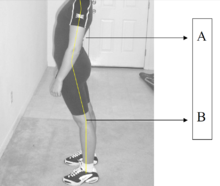Lordosis
The lordosis ( Gr. Λορδός lordós "curved forward") is a curvature (bend) of the spine to the front, so that a hollow back arises when it is very pronounced ( hyperlordosis ) . The curve backwards (with a "rounded back") is known as kyphosis .
Physiological curvature and pathological changes
In humans, a lordosis in the cervical spine (cervical) and lower back (lumbar) normal ( physiologically ). Like kyphosis , it cushions axial shocks. Only clearly increased curvatures or stretching of the spine justify complaints up to chronic clinical pictures and damage. The illustration shows a normal posture of the spine with breast kyphosis in the middle of the picture and the lumbar lordosis below.
Hyperlordosis
A hollow back or hyperlordosis is a poor posture with increased lordosis of the lumbar spine, in which the abdominal area bulges forward due to the displacement of the pelvis. In order not to fall forward, the chest is shifted behind the axis of the body (chest kyphosis ). The abdominal muscles prevent tipping backwards by being permanently tense in the stretch. The trigger can be, on the one hand, insufficiently trained, shortened hypertonic back muscles due to lack of exercise or incorrect posture , which inhibit the function of the abdominal muscles as an opponent by not relaxing. In addition, hypertonic and therefore non-extendable back muscles, which compress the spine and the rear parts of the vertebral segments on one side, can be a reason for herniated discs , spinal canal stenosis and sliding vertebrae . At an advanced stage, a hollow back can cause back pain . To improve this poor posture , back exercises, relaxation techniques, breathing techniques and manual physiotherapeutic techniques can be used to detonate the back muscles.
Dose lordosis of the cervical spine and hyperextension
Sedentary activity leads to delordosis in the area of the cervical spine (partial elimination of the physiological curvature) and even hyperextension. A lumbar support can help .
Genetically determined varieties
With pygmies and some other West African ethnic groups there is the genetically determined variety of a non-diseased pronounced hollow back.
See also
Individual evidence
- ↑ Wolfgang Miehle: Joint and spinal rheumatism. Eular Verlag, Basel 1987, ISBN 3-7177-0133-9 , p. 174 f.

